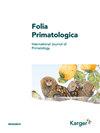杜克狐猴中心对四种狐猴学习能力的初步比较
IF 0.8
4区 生物学
Q2 ZOOLOGY
引用次数: 0
摘要
尽管狐猴是一种适应性辐射,并且作为现存最基本的灵长类谱系,在系统发育方面占据着关键地位,但在认知研究中,狐猴的研究相对不足。现有的许多研究都只关注一种狐猴。我们的目的是通过在北卡罗来纳州杜克狐猴中心对来自四个属的66只狐猴的学习能力进行比较研究。在试验过程中,我们使用了一个新颖的双动拼图盒来评估物种间在学习速度、任务熟练度和社会容忍度方面的差异。我们发现,各属之间在成功的个体百分比、个体触摸设备的潜伏期以及个体观察到团队成员成功的次数方面存在差异。Eulemur和Varecia的潜伏期更短,与Propithecus和Lemur相比,同种动物观察到的次数更多。较短的潜伏期可能表明恐惧减少或动机增强,而较高的观察率则表明对谜题框有更多的宽容或容忍。这些结果可能是由于物种在优势和等级等级上的差异;Propithecus和Lemur比Eulemur和Varecia更专制,Eulemur的一些物种表现出性别共同优势,Varecia生活在具有高裂变聚变动力学的群体中。我们还表明,即使在这些总体关系中,通过研究试验,不同的属在这些学习变量的时间轨迹上也有很大差异。总的来说,这项比较研究为狐猴的分类单元特定学习轨迹提供了初步见解,并有助于研究狐猴认知的越来越多的文献。本文章由计算机程序翻译,如有差异,请以英文原文为准。
Preliminary comparisons of learning across four lemur genera at the Duke Lemur Center
Lemurs have been relatively understudied in cognitive research despite representing an adaptive radiation and occupying a key phylogenetic position as the most basal extant primate lineage. Many of the existing studies have focused on only one lemur species. We aimed to take a comparative approach by examining learning abilities in 66 lemurs from four genera at the Duke Lemur Center in North Carolina. We used a novel two-action puzzle box to assess inter-species variation in learning speed, task proficiency, and social tolerance during trials. We found differences between genera in the percentage of individuals who had successes, individuals’ latency to touch the apparatus and the number of times an individual observed a group member’s success. Eulemur and Varecia had shorter latencies and were observed more by conspecifics compared to Propithecus and Lemur. Shorter latencies may indicate reduced fear or increased motivation, while higher observation rates suggest more leniency or tolerance around the puzzle boxes. These results may be due to species differences in dominance and rank hierarchies; Propithecus and Lemur are more despotic than Eulemur, where some species exhibit sex co-dominance, and Varecia, which live in groups with high fission-fusion dynamics. We also show that even within these overall relationships, the different genera varied substantially in the temporal trajectory of these learning variables through the study trials. Overall, this comparative study provides preliminary insights into the taxon-specific learning trajectories of lemurs and contributes to the growing body of literature examining lemur cognition.
求助全文
通过发布文献求助,成功后即可免费获取论文全文。
去求助
来源期刊

Folia Primatologica
生物-动物学
CiteScore
3.30
自引率
10.50%
发文量
36
审稿时长
>12 weeks
期刊介绍:
Recognizing that research in human biology must be founded on a comparative knowledge of our closest relatives, this journal is the natural scientist''s ideal means of access to the best of current primate research. ''Folia Primatologica'' covers fields as diverse as molecular biology and social behaviour, and features articles on ecology, conservation, palaeontology, systematics and functional anatomy. In-depth articles and invited reviews are contributed by the world’s leading primatologists. In addition, special issues provide rapid peer-reviewed publication of conference proceedings. ''Folia Primatologica'' is one of the top-rated primatology publications and is acknowledged worldwide as a high-impact core journal for primatologists, zoologists and anthropologists.
 求助内容:
求助内容: 应助结果提醒方式:
应助结果提醒方式:


